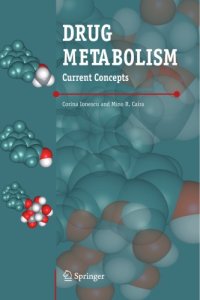
Ebook: Drug metabolism: current concepts
Author: Caira Mino R., Ionescu Corina
- Tags: Biomédecine, Drugs--Design, Drugs--Metabolism, MEDICAL--Drug Guides, MEDICAL--Nursing--Pharmacology, MEDICAL--Pharmacology, MEDICAL--Pharmacy, Pharmaceutical Preparations--metabolism, Sciences de la vie, Electronic books, Drugs -- Design, Drugs -- Metabolism, Pharmaceutical Preparations -- metabolism, MEDICAL -- Drug Guides, MEDICAL -- Pharmacology, MEDICAL -- Pharmacy, MEDICAL -- Nursing -- Pharmacology, Biomédecine
- Series: Education in the Asia-Pacific region 7
- Year: 2006
- Publisher: Springer
- City: Dordrecht
- Language: English
- pdf
Provides a comprehensive understanding of the processes that take place following ingestion of a medicinal agent or xenobiotic, with an emphasis on the crucial role of metabolism (biotransformation). This book also explains how a sound knowledge of these phenomena is incorporated into the design of effective new drug candidates.;Machine derived contents note: CHAPTER 1. DRUG METABOLISM IN CONTEXT 1 -- 1.1 INTRODUCTION -- 1.2 ABSO RPTION 3 -- 1.2.1 Basic mechanisms of transport through membranes 17 -- 1.3 DRUG DISTRIBUTION 21 -- 1.3.1 Qualitative aspects 21 -- 1.3.2 Kinetic aspects 22 -- 1.4 DYNAMICS OF DRUG ACTION 25 -- 1.4.1 Drug-receptor interaction 25 -- 1.4.2 Mechanisms 27 -- 1.4.3 Further aspects 28 -- 1.5 DRUG CLEARANCE 29 -- 1.5.1 Drug metabolism 29 -- 1.5.2 Excretion 32 -- 1.6 DYNAMICS OF DRUG CLEARANCE 33 -- 1.6.1 Basic pharmacokinetic parameters 34 -- References 37 -- CHAPTER 2. PATHWAYS OF BIOTRANSFORMATION -- PHASE I -- REACTIONS 41 -- 2.1 INTRODUCTION 41 -- 2.2 PHASE I AND PHASE II METABOLISM: GENERAL -- CONSIDERATIONS 42 -- 2.3 OXIDATIONS INVOLVING THE MICROSOMAL -- MIXED-FUNCTION OXIDASE SYSTEM 48 -- 2.3.1 Components of the enzyme system and selected miscellaneous oxidative -- reactions (mechanisms of action) 48 -- 2.3.2 Oxidations at carbon atom centres 58 -- 2.3.3 Oxidations at hetero-atoms 82 -- 2.4 OXIDATIONS INVOLVING OTHER ENZYMATIC SYSTEMS 94 -- 2.4.1 The monoamine oxidase and other systems 94 -- 2.4.2 Other representative examples 100 -- 2.5 METABOLIC REACTIONS INVOLVING REDUCTION 102 -- 2.5.1 Components of the enzyme system 102 -- 2.5.2 Compounds undergoing reduction 103 -- 2.6 HYDROLYSIS 107 -- 2.6.1 Hydrolysis of esters 108 -- 2.6.2 Hydrolysis of amides 115 -- 2.6.3 Hydrolysis of compounds in other classes 116 -- 2.7 MISCELLANOUS PHASE I REACTIONS 116 -- 2.8 THE FATE OF PHASE I REACTION PRODUCTS 117 -- References 1 18 -- CHAPTER 3. PATHWAYS OF BIOTRANSFORMATION -- PHASE II -- REACTIONS 1 9 -- 3.1 INTRODUCTION 129 -- 3.2 GLUCURONIDATION 129 -- 3.2.1 Enzymes involved and general mechanism 130 -- 3.2.2 Glucuronidation at various atomic centres (0, S, N) 134 -- 3.3 ACETYLATION 138 -- 3.3.1 Role of acetyl-coenzyme A 138 -- 3.3.2 Acetylation ofamines, sulphonamides, carboxylic acids, -- alcohols and thiols 14 1 -- 3.4 GLUTATHIONE CONJUGATION 144 -- 3.5 OTHER CONJUGATIVE REACTIONS 147 -- 3.6 CONCLUDING REMARKS 165 -- References 167 -- CHAPTER 4. ENZYMATIC SYSTEMS INVOLVED IN DRUG -- BIOTRANSFORMATION 171 -- 4.1 INTRODUCTION 171 -- 4.2 INTERACTION BETWEEN A DRUG SUBSTRATE -- AND ANENZYME 172 -- 4.3 ENZYME SYSTEMS WITH SPECIFIC ROLES 189 -- 4.3.1 Phase I enzyme systems 189 -- 4.3.2. Phase II enzymes 202 -- 4.4 FINAL REMARKS 204 -- References 204 -- CHAPTER 5. INDUCTION AND INHIBITION OF -- DRUG-METABOLISING ENZYMES 209 -- 5.1 INTRODUCTION 209 -- 5.2 INDUCTION 210 -- 5.2.1 Induction of the Cytochrome P450 system 210 -- 5.2.2 Induction of other enzyme systems 213 -- 5.3 INHIBITION 214 -- 5.3.1 Inhibition of the Cytochrome P450 system 214 -- 5.4 CONSEQUENCES OF THE ABOVE PHENOMENA 219 -- 5.5 DIETARY AND NON-DIETARY FACTORS IN ENZYME -- INDUCTION AND INHIBITION 220 -- References 2 34 -- CHAPTER 6. FACTORS THAT INFLUENCE DRUG -- BIOTRANSFORMATION 243 -- 6.1 INTRODUCTION 243 -- 6.2 INTRINSIC FACTORS 244 -- 6.2 .1 Species 24 4 -- 6.2.2 Sex 253 -- 6 .2 .3 Age 2 54 -- 62.4 Pathological status 258 -- 6.2.5 Hormonal control of drug metabolism -- selected examples 261 -- 6.3 ENVIRONMENTAL FACTORS 262 -- 6.4 FURTHER OBSERVATIONS 263 -- References 264 -- CHAPTER 7. IMPACT OF GENE VARIABILITY ON DRUG -- METABOLISM 269 -- 7.1 INTRODUCTION 269 -- 7.2 BASIC PRINCIPLES OF PHARMACOGENETICS 269 -- 7.2.1 Species-dependent biotransformations and their genetic control 274 -- 7.3 PHARMACO-INFORMATICS 287 -- 7.4 IMPLICATIONS FOR THIRD MILLENNIUM MEDICINE 288 -- References 289 -- CHAPTER 8. DRUG INTERACTIONS AND ADVERSE REACTIONS 295 -- 8.1 INTRODUCTION 295 -- 8.2 DRUG-DRUG INTERACTIONS 295 -- 8.2.1 Definitions, concepts, general aspects 295 -- 8.2.2 Interactions associated with the pharmacodynamic phase 297 -- 8.2.3 Pharmacokinetic interactions: incidence and prediction 300 -- 8.2.4 Interaction during the biotransformation phase 305 -- 8.2.5 Other selected, miscellaneous recent examples 308 -- 8.2.6 Other frequent and relevant interactions 314 -- 8.3 INTERACTIONS BETWEEN DRUGS AND OTHER ENTITIES 325 -- 8.3.1 Drug-food interactions 325 -- 8.3.2 Interactions with alcohol 327 -- 8.3.3 Influence of tobacco smoke 328 -- 8.4 ADVERSE REACTIONS 329 -- 8.4.1 Classification criteria 329 -- 8.4.2 Selected examples 333 -- 8.5 SUMMARY 348 -- CONCLUDING REMARKS 351 -- References 35 1 -- CHAPTER 9. STRATEGIES FOR DRUG DESIGN 369 -- 9.1 INTRODUCTION 369 -- 9.2 PHARMACOKINETICS AND METABOLISM IN -- DRUG RESEARCH 369 -- 9.2.1 General overview 369 -- 9.2.2 The prodrug approach 372 -- 9.2.3 The hard drug approach 385 -- 9.2.4 The soft drug approach 390 -- 9.2.5 Strategies based on Chemical Delivery Systems 394 -- 9.3 THE ROLE OF FORMULATION 405 -- 9.4 CONCLUDING REMARKS 407 -- References 40 8.
Download the book Drug metabolism: current concepts for free or read online
Continue reading on any device:

Last viewed books
Related books
{related-news}
Comments (0)